español
|
español |
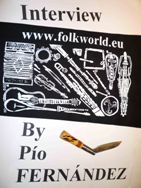
ANA ALCAIDE
Swedish & Spanish Music Traditions
A previous ‘Folk & The City’ article on Madrid introduced a local musician, who has fused the sound of the Swedish nyckelharpa with traditional songs from central Spain and the Sephardic (Spanish-Jewish) repertoire. FolkWorld went to the city of Toledo to meet Ana Alcaide and to get first hand information about her unusual but fruitful crossover.
Madrid, Malmö, Toledo, ...
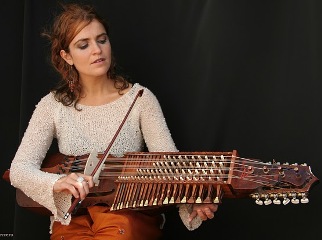 Ana Alcaide @ FolkWorld: FW#41
|
Ana ALCAIDE was born and raised in Spain’s capital and geographical center point, Madrid, where she got her university degree in biology. Thanks to an Erasmus scholarship to study in Sweden’s University of Lund, she lived in the city of Malmö (in the southernmost Swedish province of Scania). During her stay, Ana also dedicated time to continue playing and learning the violin, the instrument that she had been taught since childhood. That got her in contact with the traditional ‘keyed fiddle’ from Sweden: the Nyckelharpa, an instrument that combines a keyboard with tangents, like in the hurdy-gurdy, with the bow that frictions the strings, such as on a viol or a fiddle.
After finishing her studies, she went back to Madrid and played her string instruments with a number of local folk and Celtic music bands. She also worked on her own musical projects, and since 2006 Ana has released two CDs and a DVD in cooperation with local and foreign musicians.
Since 2006, Ana lives 70 km South of Madrid, in Toledo’s downtown. For someone interested on the Castilian, Sephardic and Medieval music to move to the nearby city of Toledo is a wise choice. This city keeps a beautiful and extensive old town with stone buildings, narrow streets, churches, mosques and synagogues, providing the right atmosphere to concentrate and get inspired by the rich historical and cultural heritage of the place.
While visiting Ana in Toledo, we also had the chance to meet the nyckelharpist and ‘ghironda’ (hurdy-gurdy) musician Renzo RUGGIERO from the Italian band PÌVARI TRIO. Both Ana and Renzo participate in a tri-national European project (Sweden, Germany, Italy) whose aim is the spread of the interest and the knowledge on the nyckelharpa beyond the borders of Sweden. The name for this project is: EUROPEAN NYCKELHARPA TRAINING.
But let’s first see what Ana told us about her experiences in the Swedish folk music and with the nyckelharpa.
Experiencing Traditional and Folk Music in Sweden
|
Toledo's Three Cultures – Christian, Jewish, Muslim  Toledo’s foundations are traced back to the Bronce Age. The Romans occupied the Iberian peninsula (today’s Spain & Portugal), starting in 218 BC and fighting against a number of different tribes (Iberian, Celtic, Basque, Cantabrian, Asturian, Lusitanian,…) spread over the territory. The name given by the conquerors to the peninsula was Hispania. Toledo (Toletum in Latin) became then a significant commercial & administrative center in what was at the time the province of Tarraconensis. The presence of Jewish peoples in the Iberian peninsula can be traced back to those days of the Roman Empire, or even earlier.
In 415, the Visigoths entered the peninsula. They were a west-travelling group of the Nordic-Baltic-Germanic Goth tribes that spread throughout Europe at the decay of the Roman Empire. By the end of the 5th century, Toledo became the capital of the Visigothic kingdom in Hispania, beginning with king Liuvigild (Leovigildo). These peoples of North-Eastern European origin (but having already assimilated the remains of the Roman culture & the Christian religion) ruled in Spain until the 8th century, when new invaders coming across the Mediterra-nean sea, defeated & killed the last king of the Hispanic Goths: Roderick (Rodrigo).
These new invaders were the Arabs, Berbers, Moors, that since 711 settled on most of the Iberian peninsula starting from the south. The conquered territories in Spain were named Al-Andalus. Under their Cali-phate (with capital in the city of Cordoba), Toledo enjoyed a golden age where Muslim, Christian & Jewish communities coexisted in the city. Neverthe-less, because of its central location in the peninsula, Tole-do became a crucial place in the eight centuries struggles bet-ween the Muslim rulers spread in the central & South territories, and the Christian nobility withdrawn in the lands at the North (León, Castilla, Navarra).
In 1085 the Christian king Al-fonso VI of Castile took Toledo. After the Castilian conquest, the life for the Muslim & Jewish communities started to become difficult. Nevertheless, Toledo remained as a main cultural centre; its Arab libraries were not savaged, and a tag-team translation centre was estab-lished, in which books in Arabic would be translated from Arabic or Hebrew to Spanish by Arab and Jewish scholars, and from Spanish to Latin by Castilian scholars, thus letting the old-lost knowledge (the one from ancient Greece, Egypt,…) spread through Christian Europe again.
King Alfonso X ‘El Sabio’ (‘The Wise’) was born in Toledo in 1221. He was the eldest son of Ferdinand III of Castile & Elisa-beth of Hohenstaufen, through whom he was a cousin of Frede-rick II, Holy Roman Emperor, with whom Alfonso is often compared. Alfonso X became a relevant supporter of the Toledo School of Translators, and his interest in diverse knowledge, particularly in literature and music, lead to the compilation of Cantigas de Santa Maria ("Songs to the Virgin Mary"), which was written in Galician-Portuguese language, and it is one of the largest collections of vernacular monophonic songs to survive from the Middle Ages. They consist of 420 poems with musical notation, mainly about miracles attributed to the Virgin Mary.
In 1492, during the reign of Fernando de Aragón & Isabel de Castilla (‘The Catholic Monarchs’), Columbus arrived in America, and the last Muslim city in the South of Spain, Granada, was taken by the Christians. Shortly after, the already difficult coexistence between different creeds & communities came to an end: Moors & Jews were forced to convert to Christianity or to leave Spain. Large groups of Jews left Spain (Sefarad, in their Spanish-Hebrew ‘Ladino’ language) and established their communities along several Mediterranean cities, from Morocco up to Turkey, but also other places in Europe and even South America, often keeping their ancient Spanish tongue, traditions, songs and memories from the land they had left behind. The Moorish peoples (Moriscos) were finally expelled in 1609 and sent back to places in Northern Africa, where they arrived with their ‘Andalusi’ Spanish-Arab culture.
During the 16th century, Spain’s court was moved from Toledo to the north Castilian city of Valla-dolid, and finally to Madrid by Philip II in 1561.
|
Ana ALCAIDE went to Sweden as a biologist and came back to Spain to become a professional musician. She had been learning to play the violin since her childhood. Therefore, while completing her one year scholarship in Lund’s university, the fiddle was the vehicle that got her involved in the local music scene and on the learning of the nyckelharpa. Once she had finished her biology studies, she took the decision to go on with her Swedish experience. She went back to Malmö’s Academy of Music to continue studying for three more years, but this time to complete her musical education, mainly focused on the nyckelharpa.
In Sweden, Ana found that although the local traditional music is a bit unknown in the rest of Europe (compared to Irish music, for example), the population over there is still extensively respectful and attached to their musical heritage.
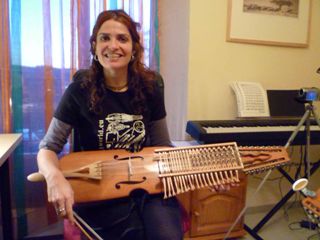 They have a continuous tradition of old and young people meeting together in sessions to sing, play and dance their folk music (the polska is its most characteristic dance tune), in a similar way to the ‘céilí or ‘cèilidh’ tradition in Ireland and Scotland.
They have a continuous tradition of old and young people meeting together in sessions to sing, play and dance their folk music (the polska is its most characteristic dance tune), in a similar way to the ‘céilí or ‘cèilidh’ tradition in Ireland and Scotland.
On top of that, the Swedish conservatories and music schools are not limited to the teaching of classical music only. They have integrated the learning of popular music in their official programs: jazz, rock, folk, … and not just from Sweden’s tradition.
During that period, Ana had the chance to play in public for example with the Danish singer Sussie NIELSEN and with the Iranian musician Reza SHAYESTEH. Reza was also one of Ana’s teachers on traditional music at Malmö’s University, and he has continued playing with Ana in some concerts in the last years. I recall one in Madrid’s music bar GALILEO GALILEI where Ana and Reza both played the Tambour, which is a string instrument traditional in Persia.
Ana is a fan of all kinds of traditional string instruments besides the violin, the nyckelharpa and the tambour. During her Scandinavian experience she had the chance to learn and get other instruments such as the Moraharpa and the Hardanger fiddle. The Moraharpa is also an old keyed string instrument which was found for the first time in the Swedish town of Mora. It has a more simplified configuration than the nyckelharpa. The fiddle from Hardanger is used in Norwegian traditional music. It has a higher pitch than the standard classic violin, and it has sympathetic or resonant strings lying underneath each of the four fretted upper ones. In that respect, it is similar to the viola d’amore, or even the nyckelharpa.
Nyckelharpa, Moraharpa & Others
The Swedish word Nyckelharpa is composed of:
In the last centuries, Sweden and in particular the province of Uppland (on Sweden’s Eastern coast, just North of Stockholm) has become the place in Europe keeping the tradition for this peculiar kind of instrument.
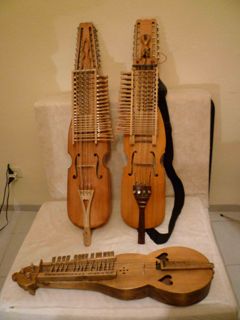 Nevertheless, references and illustrations to this kind of keyed fiddle have been found in documents and sculptures in other parts of Europe (Norway, Finland, Germany, Belgium, Italy,...) dated in Medieval and Renaissance times.
Nevertheless, references and illustrations to this kind of keyed fiddle have been found in documents and sculptures in other parts of Europe (Norway, Finland, Germany, Belgium, Italy,...) dated in Medieval and Renaissance times.
The most significant Swedish personality on the recuperation of the nyckelharpa in recent times is Eric SAHLSTRÖM. As musician, composer and nyckelharpa builder, he initiated a great interest in the instrument and the making of thousands of them in Sweden since around 1970. Although he died in 1986, his work is continued by his daughter Sonia and the Eric SAHLSTRÖM INSTITUTET in the village of Tobo (Uppsala County).
Today’s Swedish nyckelharpas are built with narrow and long soundboxes. The total length of the instrument and the way to hold it with the hands (with the help of a strap around the neck) resemble those of a guitar. The difference is that (for a right handed musician) the fingers of the left hand press the keys on the side of the mast, while the right hand frictions the strings by means of bow about half the length of the one for the violin.
The traditional nyckelharpas have three upper strings which vibrate by the direct friction/fretting of the bow. These are the melody strings. Then, there are thinner strings laying under each of those fretted upper ones and tuned to vibrate by resonance or ‘sympathy’ with them . The modern chromatic nyckelharpa has 16 strings: 3 melody strings, 12 sympathetic strings, and one drone string (having no resonant strings underneath). The mechanism of sliding wooden keys placed under the strings is similar to the tangents in the hurdy-gurdy (probably more complex). Their function is to press the corresponding strings at different lengths in order to achieve the chromatic scale of notes in different octaves. The nyckelharpa has a 3 octave range, from the same low ‘G’ as a fiddle’s 4th string. At the end, this defines a keyboard of up to 37 keys arranged in 3 rows on the traditional Swedish nyckelharpas, and up to 4 rows of keys in the less traditional instruments.
The nyckelharpas are built with woods such as spruce or walnut for the sound box, and birch for the keys.
The traditional nykelharpa makers are in Sweden (more than 10 nowadays), although there are also luthiers in other countries. Ana ALCAIDE has nyckelharpas built by:
But there are also luthiers for example in Italy, such as Paolo CORIANI in Modena, or Lino MOGNASCHI in Parma.
A more primitive version of these key fiddle instruments is the Moraharpa. It takes the name from the town of Mora in the central Swedish province of Dalarna. The moraharpa has a soundbox shaped with two intersecting round bodies.
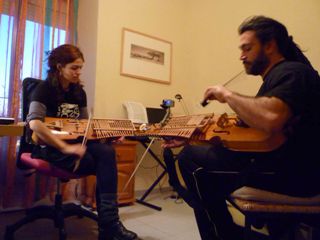 It has just three melodic strings (none resonant), and its diatonic keyboard has a single row of keys.
Ana’s moraharpa is built by
Leif ERIKSSON, but there are other Swedish makers such as
Björn BJÖRN
who also manufactures other varieties of these key fiddles such as the Kontrabassharpa and the Silverbasharpa.
It has just three melodic strings (none resonant), and its diatonic keyboard has a single row of keys.
Ana’s moraharpa is built by
Leif ERIKSSON, but there are other Swedish makers such as
Björn BJÖRN
who also manufactures other varieties of these key fiddles such as the Kontrabassharpa and the Silverbasharpa.
There are also other types such as the Enkelharpa, the Mixturharpa and the Öysterbyharpa. All of them are described in the web page from the ANA (American Nyckelharpa Association) in the section Home » About » What is a nyckelharpa? » Nyckelharpa History.
We asked Ana ALCAIDE about recommended recordings for someone interested in getting familiar with the music of these fascinating instruments. Her list is extensive (mostly Swedish bands and musicians, of course), but to provide a short helpful hint she mentioned the known VÄSEN [FW#41] and HEDNINGARNA [FW#28], and the lesser known:
Regarding resources for diverse information on these keyed fiddles in the internet, it is just a matter of browsing with the right spelling of the word, and for example going to the ANA web page, meaning : American Nyckelharpa Association. This is one of the top pages providing links to several other key nickelharpa organizations all over the world .
We then asked Ana ALCAIDE about the advisable way for someone who wants to fully jump into the nyckelharpa world and learn how to play it. She admitted that nowadays going to a school in Sweden (as she did) is the most direct solution. However, there could be teachers found in other European countries such Germany, Italy or Belgium, for example through the spin off from the projects described below in this article.
The Work on Spanish and Sephardic Music
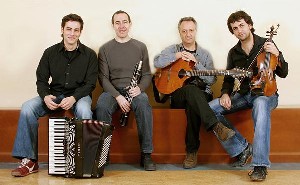
La Musgaña @ FolkWorld: |
It was the ‘Musgaño’ Carlos BECEIRO who produced Ana’s first CD ‘Viola de Teclas’/‘Keyed Viol’ (2006), then followed by ‘Como la Luna y el Sol’/‘Like the Moon and the Sun’ (2007). Both were published by La MUSGAÑA’s record label: LUBICAN Records.
Nowadays, the duo of Ana ALCAIDE (nyckelharpa, fiddles, …) and Carlos BECEIRO (hurdy gurdy, plucked string instruments) are frequent artists performing in Madrid’s legendary Irish and folk pub LA TABERNA DE ELISA and other places.
On the CD ‘Viola de Teclas’, Ana presents a compilation of traditional songs and medleys of diverse origin:
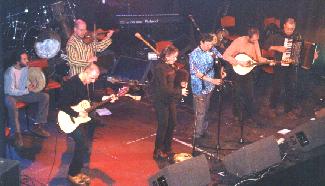
Berrogüetto @ FolkWorld: |
On the second CD ‘Como la Luna y el Sol’, Ana gets deeper into the subject of the Sephardic music, probably influenced by the atmosphere of the city of Toledo where she lives. This is the traditional music of the Spanish speaking communities of Jewish people settled in several places of the world (mostly in Mediterranean countries), after their ejection from Spain in 1492. The Judaeo-Spanish language of these lyrics is known as ‘Sefardí’ or ‘Ladino’, being a kind of old Spanish, heavily influenced by Hebrew and Aramaic, but also Arabic, Turkish and to a lesser extent Greek. The songs are from Sephardic communities in Bulgaria, Turkey, Greece and Morocco, but there are also a few instrumentals composed by Ana.
Her last recording is the DVD ‘Ana ALCAIDE en Concierto’ recorded in Toledo’s Sinagoga del Tránsito (Lubicán Records, 2009), playing with Carlos BECEIRO and Jaime MUÑOZ from La Musgaña, and Bill COOLEY, a musician from New York specialized in medieval music and instrument construction. The songs they play are basically a compilation from Ana’s two previous CDs, but it is very interesting to see them played with unusual instruments and inside the beautiful architecture of this synagogue founded in 1356. The instruments they play are:
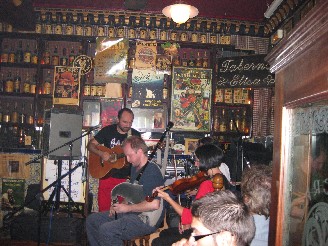
Balbarda @ FolkWorld: FW#39, #41 |
In her previous two CDs, Ana also played other kinds of instruments such as: violin, bendhir, rabel (Spanish rebec), built by Asier DE BENITO, viol, harmonium, Hardanger fiddle, santur, harps,…
Ana ALCAIDE’s relationship with Toledo has become very strong. She has attracted great attention in the city playing with medieval, Sephardic and Arabic music ensembles, as well as with the sound of her enchanting nyckelharpa music in front of Toledo’s cathedral on weekends. Different city media have interviewed her, and local authorities have partially sponsored her three recordings.
Ana’s introduction of the nyckelharpa to the professional folk music of Castile and Spain is quite pioneering, probably only preceded by the Basque violinist Xabier ZEBERIO, who has played it in the folk band OSKORRI and in ALOS QUARTET. Another musician, who is not just playing the nyckelharpa but even building them, is the fiddler from the innovative Galician folk band BERROGÜETTO, Quim FARINHA, who introduces the instrument in their fifth CD ‘Kosmogonías’, self-edited by the band in March 2010.
Nyckelharpa Projects in 2010
Up to now, although she is not of Jewish ascendance, Ana ALCAIDE has dedicated a special focus to the Spanish and the relatively unknown Sephardic music, played with the above described Nordic viols. This is a quite unique approach, also considering the geographical and cultural distance between repertoires and instruments.
But at least for the first part of this year, Ana wants to go back and concentrate on increasing her experience on the keyed fiddles, and exchanging musical ideas with the communities of players in Europe. She will do it through the international project named EUROPEAN NYCKELHARPA TRAINING. Their activities will take place every other month in three key places such as:
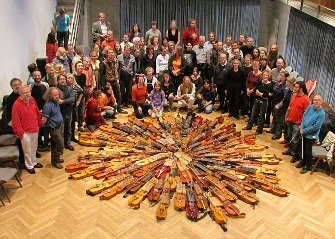 A recent meeting for these series of seminars was in April 2010 in the above mentioned school in Forlimpopoli, the leading teacher being
Ditte ANDERSSON. She is a Swedish nyckelharpist, who also sings and plays the fiddle, graduate of the Royal College of Music in Stockholm and a teacher at all three of the abovementioned partner institutes. Ana ALCAIDE has participated in this course as a student.
A recent meeting for these series of seminars was in April 2010 in the above mentioned school in Forlimpopoli, the leading teacher being
Ditte ANDERSSON. She is a Swedish nyckelharpist, who also sings and plays the fiddle, graduate of the Royal College of Music in Stockholm and a teacher at all three of the abovementioned partner institutes. Ana ALCAIDE has participated in this course as a student.
Ana will participate as a teacher in the annual Burg Fürsteneck nyckelharpa meeting in October 2010, specialized on early music from the Iberian peninsula. There is another parallel project also running in these three places called CADENCE: Cultural Adult Education & Nyckelharpa Cooperation in Europe.
Another teacher in the EUROPEAN NYCKELHARPA TRAINING and CADENCE is Renzo RUGGIERO mentioned in the beginning of this article, who is part of the Italian traditional music band PÌVARI TRIO and in the contemporary music band ARKITÉSI.
PÌVARI TRIO have published three CDs, the latest one in 2005: ‘E ghè pü temp che vita / C’è più tempo che vita’ (Edizioni Musicali Folkclub Ethnosuoni). It has folk songs played with nyckelharpa, vocals, violoncello, piano, harmonium, clarinet, flute, ocarina, … The two previous ones were:
The idea for these pan-European projects came from Marco AMBROSINI, who is also one of the teachers in these courses. There are in total up to 6 teachers from Sweden (two of them from the Eric SAHLSTRÖM INSTITUTE), plus 5 from Germany, 5 from Italy, one from Belgium and one from Austria.
It seems that Ana ALCAIDE’s involvement in all these intense nyckelharpa activities could become a turning point in her work with the instrument. Considering the brilliance and the success that her proposal has achieved in central Spain’s folk scene just in the last three years, it is really worth waiting for her following projects.
Photo Credits:
(1) Logo,
(4) Ana Alcaide,
(5) Ana Alcaide's & Renzo Ruggiero's nyckelharpas,
(6) Ana Alcaide & Renzo Ruggiero,
(9) Balbarda (by Pio Fernandez);
(2) Ana Alcaide,
(7) La Musgana,
(10) European Nyckelharpa Training @ Burg Fürsteneck
(from website);
(3) Toledo (by Wikipedia);
(8) Berrogüetto (by The Mollis).
|
To the German FolkWorld |
© The Mollis - Editors of FolkWorld; Published 07/2010
All material published in FolkWorld is © The Author via FolkWorld. Storage for private use is allowed and welcome. Reviews and extracts of up to 200 words may be freely quoted and reproduced, if source and author are acknowledged. For any other reproduction please ask the Editors for permission. Although any external links from FolkWorld are chosen with greatest care, FolkWorld and its editors do not take any responsibility for the content of the linked external websites.
